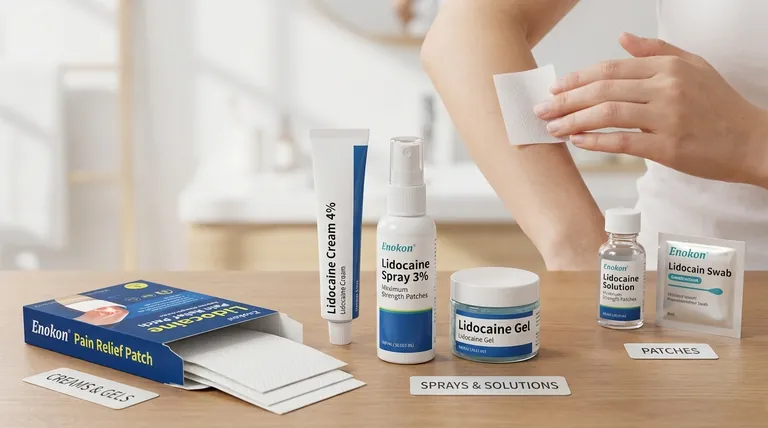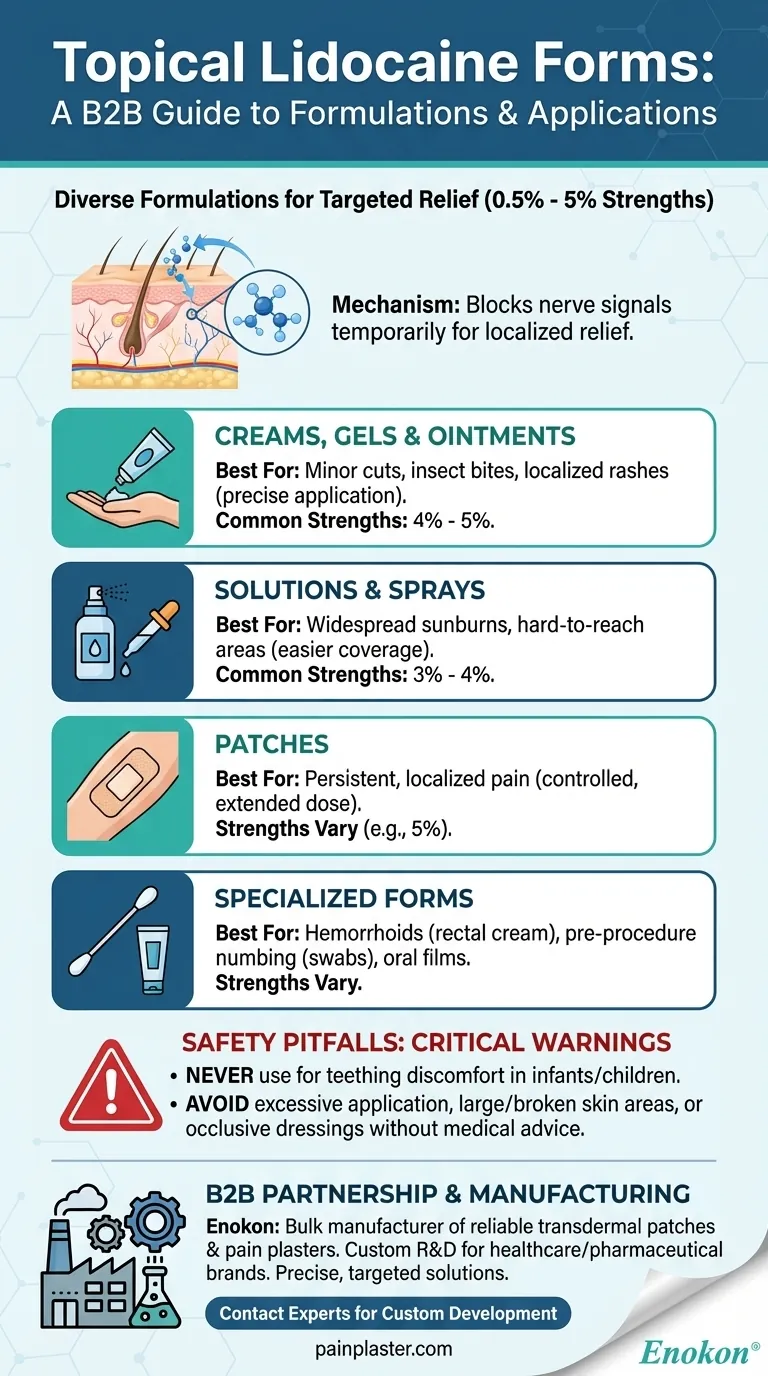Topical lidocaine is available in a wide array of formulations, designed to suit different applications and areas of the body. These include common forms like creams, gels, lotions, ointments, and patches, as well as more specialized options such as solutions, sprays, powders, swabs, and films. These products come in various strengths, typically ranging from 0.5% to 5%, allowing for tailored levels of pain relief.
The sheer variety of topical lidocaine forms is intentional. The goal is to provide a targeted anesthetic effect precisely where it's needed, with the choice of formulation—be it a cream, patch, or spray—depending entirely on the location, size, and nature of the area requiring treatment.

How Topical Lidocaine Delivers Relief
The Core Mechanism of Action
Lidocaine is a local anesthetic. When applied to the skin, it works by temporarily blocking the nerve signals in that specific area.
This action prevents pain and itching sensations from traveling from the skin to the brain, providing effective but temporary numbness and relief.
The Advantage of Targeted Application
The primary benefit of topical lidocaine is its ability to deliver pain relief directly to the source of discomfort.
This targeted approach avoids the full-body, or systemic, effects that can come with oral pain medications, making it a favorable choice for managing localized, acute pain.
A Guide to Common Formulations and Their Uses
Creams, Gels, and Ointments
These semi-solid formulations are ideal for treating well-defined, localized areas of skin irritation.
They are commonly used for conditions like minor cuts, scrapes, insect bites, or rashes where precise application is necessary. Common over-the-counter strengths are 4% and 5%.
Solutions and Sprays
Liquid and spray forms provide a convenient way to cover larger or more sensitive areas of the body where rubbing in a cream might be painful.
They are particularly well-suited for conditions like widespread sunburns or hard-to-reach areas. You will often find these in 3% or 4% concentrations.
Patches
Lidocaine patches are designed to provide a consistent, controlled dose of medication over an extended period.
This makes them an excellent choice for managing persistent and localized pain, as the patch adheres to the skin and slowly releases the anesthetic.
Specialized Forms
Other formulations exist for very specific medical needs. These include rectal creams for hemorrhoid relief, swabs for pre-procedure numbing, and films for oral applications.
Common Pitfalls to Avoid
Appropriate and Inappropriate Uses
Topical lidocaine is highly effective for pain and itching from sunburns, minor skin irritations, and hemorrhoids.
However, a critical safety warning is that it should never be used to relieve teething discomfort in infants or young children.
Proper Application is Key
While topical lidocaine has a strong safety profile, it must be used as directed.
Applying too much, using it on large areas of broken skin, or covering it with a bandage without medical advice can increase absorption into the bloodstream and lead to side effects. Always follow the product instructions carefully.
Making the Right Choice for Your Condition
Choosing the correct formulation is the key to getting the most benefit from topical lidocaine.
- If your primary focus is a minor cut, insect bite, or localized rash: A cream or gel offers precise application for effective relief.
- If your primary focus is a widespread sunburn or a hard-to-reach spot: A spray or liquid solution provides easier and more even coverage.
- If your primary focus is persistent, localized discomfort: A patch can deliver a steady, long-lasting dose of medication directly to the source.
- If your primary focus is hemorrhoid pain or itching: A specifically formulated rectal cream is the appropriate and effective choice.
Ultimately, selecting the correct form of topical lidocaine ensures you receive safe, effective, and targeted relief exactly where you need it most.
Summary Table:
| Formulation | Best For | Common Strengths |
|---|---|---|
| Creams, Gels, Ointments | Minor cuts, insect bites, localized rashes | 4% - 5% |
| Solutions & Sprays | Widespread sunburns, hard-to-reach areas | 3% - 4% |
| Patches | Persistent, localized pain | Varies (e.g., 5%) |
| Specialized Forms | Hemorrhoids, pre-procedure numbing | Varies by application |
Need a reliable, high-quality topical lidocaine product?
As Enokon, a bulk manufacturer of reliable transdermal patches and pain plasters, we understand the critical role of formulation in effective pain management. Our technical expertise is at your service for custom R&D and development, ensuring your healthcare or pharmaceutical brand gets the precise, targeted solution it needs.
Let's develop your next pain relief product together. Contact our experts today to discuss your requirements.
Visual Guide

Related Products
- Lidocaine Hydrogel Pain Relief Patch for Pain Relief
- Asthma Cough and Pain Relief Patch for Adults and Kids
- Heating Pain Relief Patches for Menstrual Cramps
- Mugwort Wormwood Pain Relief Patch for Neck Pain
- Capsaicin Chili Medicated Pain Relief Patches
People Also Ask
- Are lidocaine patches safe to use during pregnancy? A Guide to Making an Informed Choice
- How should the treated area be protected while wearing a lidocaine patch? Safety Tips for Effective Pain Relief
- Is it safe to use lidocaine patches while breastfeeding? Expert Guidance for Nursing Mothers
- When should someone contact a doctor regarding lidocaine patch use? Ensure Safe Pain Relief
- How is the lidocaine patch administered? A Step-by-Step Guide for Safe & Effective Pain Relief















